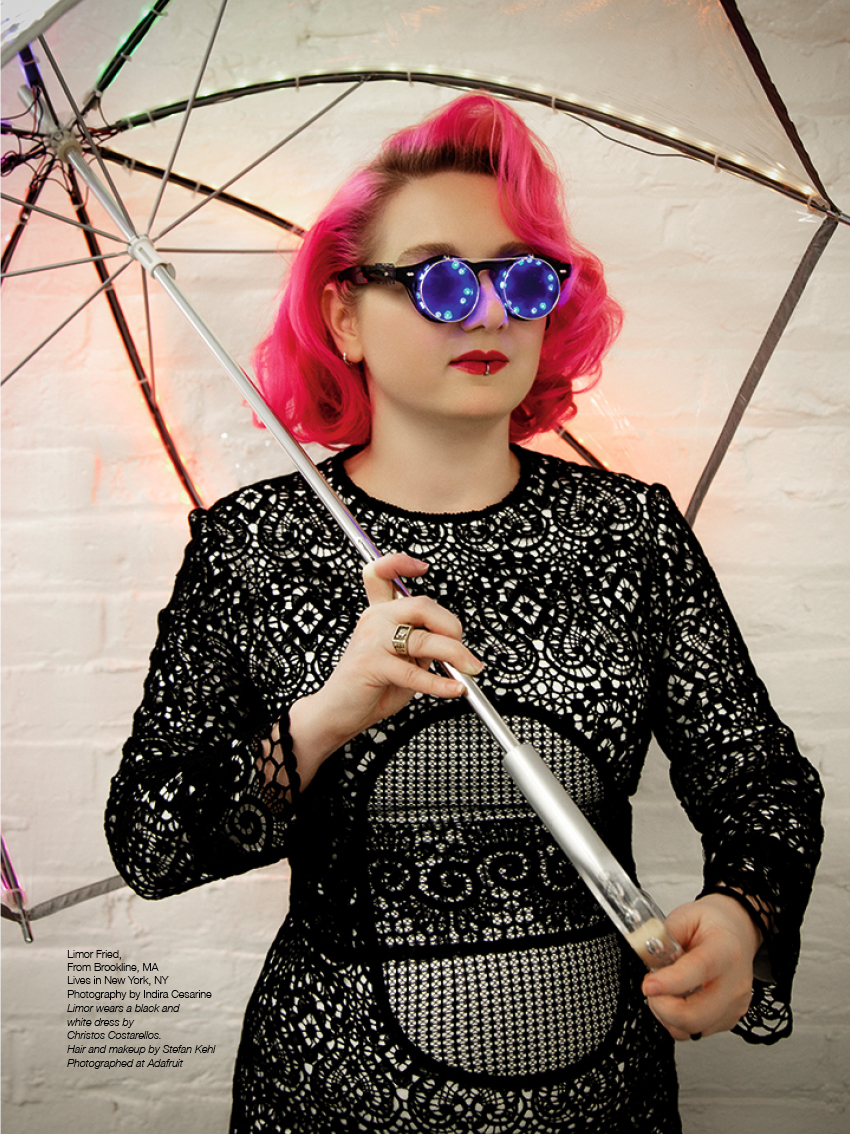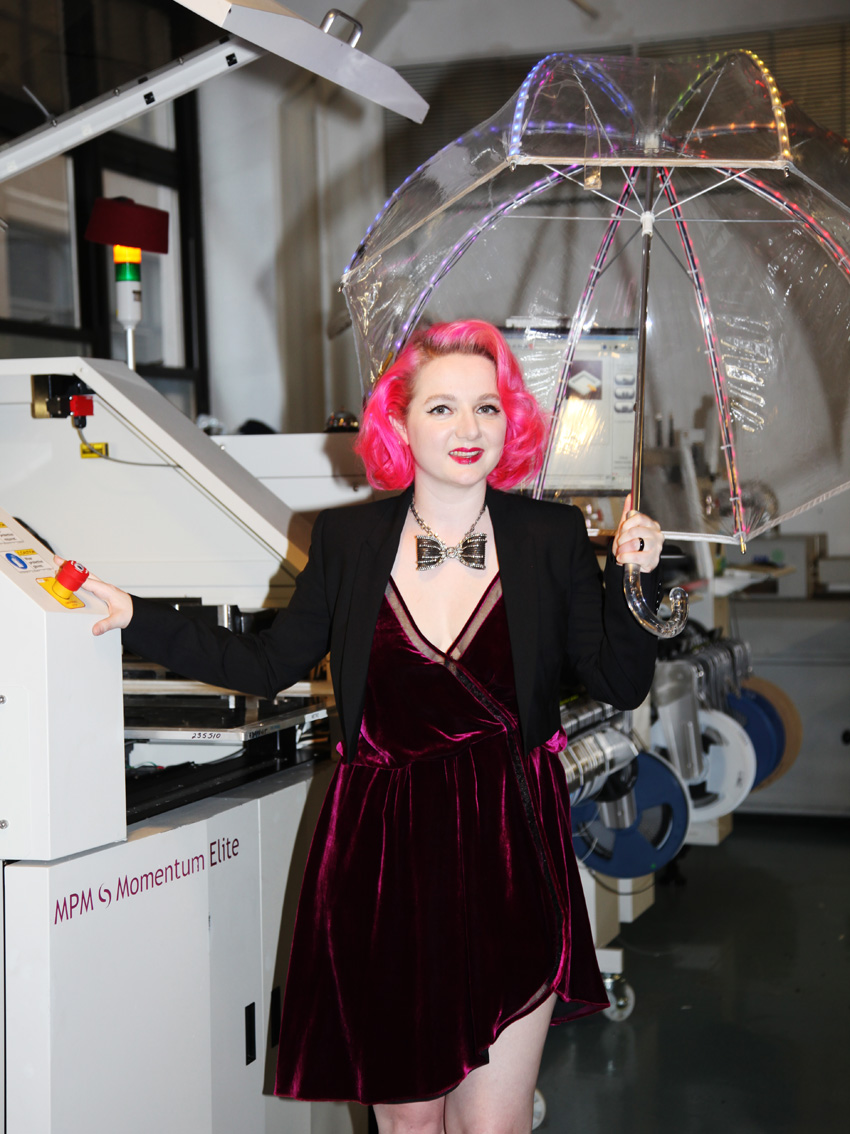
“There was no business plan or anything. There was no goal. I was just making all these projects and putting them on my website.” Limor Fried’s entrepreneurial seeds were unwittingly sewn when she started building and selling kits for a pre-iPod MP3 player that she engineered while she was studying at MIT. She sold them simply in order to cover the costs of her and her friends’ own tinkering, having no idea the impact her venture would soon have on her career. Her college endeavor flourished into a multi-million dollar business, Adafruit, with a factory and offices in Soho, New York. Fried became the first female engineer featured on the cover of Wired, and won the Most Influential Women in Technology award, given by Fast Company magazine. Limor was also named “Entrepreneur of the Year” in 2012 by Entrepreneur, the only representative for women within the fifteen finalists.
Also known in the industry as Lady Ada, Limor explained the moniker is homage to the 19th century programmer, Lady Ada Lovelace. “[She] was the first person to program… She was really interested in mathematics because she liked to gamble. She was like ‘how can I use math and statistics and computing to help me win at the races?’… She was a little bit of a wild child, outside of the mainstream.” With her pink hair and nonconventional career path, you could say the same of Limor. Heralding from a creative background, her interests and ambitions evolved naturally into computer sciences and electronics as she grew older. “I was always really creative and I liked doing arts and crafts. I was growing up when computers were starting to become common in homes. We had them in school, and we just kept playing around with them. I liked playing games, I liked making art on them. It just became one of my hobbies.” The depths of her interest in the tech industry soon grew from computer science to hands-on engineering. “I was supposed to be working on my thesis or something, but I didn’t really want to do it. Instead, I was like ‘Oh, let’s make an MP3 player’— and this was before the iPod.” The result of her impulsive decision was the creation of an MP3 player that fit into an Altoids tin. “They became really popular, and people were using them as minor music players. They were walking around like ‘Why are your headphones plugged into an Altoids tin?”
This outside-the-box (or inside of an Altoids tin) way of thinking was novel to Limor’s college cohort. When they saw how easy it was to build things for themselves, they wanted in. Limor harnessed this demand and channeled it toward covering her business overhead, as well as the costs of her own personal projects. Soon she was ordering her inventory wholesale. “If you’re building projects, say you want to make your own MP3 player, you have to get a custom circuit board. There’s no way around it. Getting that one piece costs $200, but getting 1,000 pieces costs $300! We were like, ‘Ah! We’ll get other people to go in with us on it.’ We bought enough parts to make one hundred kits, and they sold out in five minutes… Even though you could buy a lot of this stuff, people wanted to have the experience of building it themselves.”
Today, almost anything electronic you can dream up can be made possible through parts engineered by Adafruit. The 15,000 square foot factory boasts over fifty employees, with $33 million in revenue last year alone. “At a CosPlay event, people like to make their own fashion and dress up as their favorite characters. Maybe you want to dress up like a dragon from Game of Thrones, or maybe you want to dress up as like a Hunger Games character. A lot of people who do costuming and CosPlay, want to add stuff like LEDs, sounds and movement. There’s nothing off the shelf that does that until you go to Adafruit. We have all these pieces and parts that make it really easy for you to add sound effects or lights or activity — all these little building blocks of electronics. And we have these extremely detailed tutorials that show you how to do it. It makes it really easy for beginners to explore how they could integrate electronics into whatever art form that they’re currently doing, and this way, electronics is opened up beyond its stereotype of introverted guys sitting around building things.”
Now, Limor is dealing with the challenges of growing her own company, while maintaining her ethics on profitability in a cutthroat industry. “One of the big challenges is hiring really good people and keeping the company culture positive. Even though there’s all these temptations to take shortcuts, I fight it. People tell me ‘Oh, you should just take this money and rip off this person, or you should pay your people minimum wage’… You have to fight what a lot of other people tell you to do when you know what is right.” Never one to give in to such pressures, Limor continues to achieve her objectives with clarity and expediency. Being a female in the tech industry puts her in a position that could be tough, but not at the expense of her individuality. “I’m a woman. I’m doing this, and this is cool, and I can have pink hair, I can do electronics, I have my own factory and sometimes I wear makeup and sometimes I don’t. None of this affects my desire to do engineering.”
In an industry extremely dominated by men, Limor is leading by example. A massive supporter of promoting girls in tech and engineering, Adafruit supports Girl Who Code, Girl Tech and numerous other programs promoting female education. “One of my goals of Adafruit is to show that electronics and computer science is open to everybody, and it isn’t just like “If you’re not a robotics nerd, you’re not welcome.’ We have a lot of parents that they use our wearable technologies to help their daughters build prom dresses with lights, tiaras — you can add electronics to your dress, to your skateboard, to your art projects…” In a live show she does every Wednesday called “Ask An Engineer,” Limor gives demonstrations on her work and takes questions about electronics. “We have special guests, and we had one parent email us after we had my friend Amanda on the show. She’s a biomedical engineer at Harvard and was designing electronics to help premature babies with heart conditions — it helps regulate their hearts — which is really amazing. And this parent said, ‘You know I watch the show with my daughter, because I’m trying to show her what engineering can be, and after you had Amanda on, my daughter turned to me and said “Are there any guys who do engineering too? Or is it only girls?”’”
Photography and Interview by Indira Cesarine for The Untitled Magazine
This article originally appeared in The #GirlPower Issue of The Untitled Magazine (2015).



